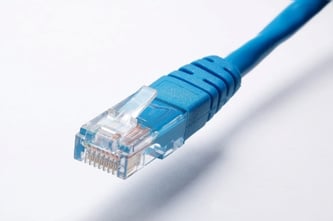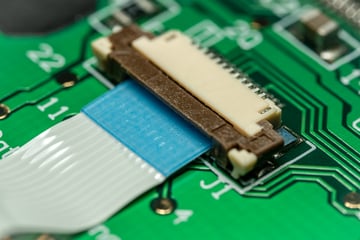Share this
Types of Electrical Wires and Cables: Buyer’s & Engineer’s Guide
by Simcona on Jun 5, 2024 1:45:00 PM

Cabling and wiring perform a range of amazing tricks in industrial assemblies. From powering motors to controlling instrumentation to communicating with other machines, they’re the secret to success in many projects.
Because industrial applications have so many unique considerations, the cable vendor often has to correct the purchaser on the best type for them. Even the project engineer(s) sometimes needs a nudge in the right direction if they’re not a wiring whiz.
To spec the right type of electrical wire and cable for your industrial project, learn the seven key categories you may run into.
(Related Resource: Wire & Cable Selection Guide)
7 Types of Electrical Wires and Cables
There are almost more ways to categorize wires and cables than you can count. Let’s stick with these common terms, as they might most affect the outcome of your project:
- Single-conductor
- Multiconductor
- Twisted pair
- Ethernet
- Coaxial
- Fiber-optic
- Ribbon
Single-Conductor Cables
A single-conductor (or single-core) cable is just that – a flexible wire with one metal conductor in the middle and insulation surrounding it.
The name, however, is kind of a technicality. Yes, single-conductor cables can exist as a lone wire for grounding or the positive leg of a low-voltage system. However, it’s common to bundle several of them into a more complex cable harness. Each wire within the assembly may carry a unique electrical signal.
Using single conductor wires reduces the bulkiness of the assembly. The installer can fan out bundles, making routing easier in tight spaces. The lack of an outer jacketing layer further increases their flexibility because they can bend at tighter radii.
That slimmer design comes at a performance cost. Single-conductor industrial cables have limited abrasion resistance and high susceptibility to electrical noise (unless you add shielding). While single-conductor wires work well in prototyping and development, a multiconductor cable is the safer option in environments with mechanical hazards and potential cross talk.
UL (Underwriters Laboratories) rates a huge range of wires for industrial use. Popular UL-approved single-conductor wires include:
- UL 1061
- UL 1569
- UL 1015
All three are usable in temperatures up to 105°C at voltages of 300V+.
Multiconductor Cables
A multiconductor (multicore) cable is a single product that combines more than one wire – anywhere from two to 60. The manufacturer twists, wraps, or otherwise binds the strands together.
Compared to their single-conductor cousins, multiconductor cables have many advantages for industrial users:
- Higher mechanical strength
- Easier to bend
- Assembled cabling is neater & more space-efficient
One example of their convenience is that several “legs” can be grouped into a main “trunk.” For instance, an appliance cable could bundle two main power wires and two low-voltage wires into a single, UL 2517-friendly package.
Customizability is the name of the game for multiconductors – you can tweak the exact type and placement of shielding to satisfy design requirements. The gauge and cable lay are also configurable for the number of circuits you need. Because the cable contains multiple strands, there’s a limit to the thickness of each wire.
Popular UL-listed multiconductor cables include:
- UL 2464
- UL 2517
- UL 2725
Twisted Pair Cables
Twisted pair cabling is a type of wire bundle that performs a special feat: It makes electromagnetic interference (EMI) disappear. The mastermind behind twisted pair cables is none other than Alexander Graham Bell.
EMI is one of the biggest obstacles to cable performance, often stemming from cross talk between neighboring components or radiation from unshielded cables. Twisted pair cables cancel out these external sources.
Common applications include:
- Telecommunications
- Sound engineering
- Theaters
- Data centers
Commercial-grade twisted pair cables come in solid or stranded construction. It’s also possible to shield the cable for additional noise protection. In custom multiconductor cables, you can personalize the gauge and shielding for each twisted pair in the assembly.
 Ethernet Cables
Ethernet Cables
You may know this type as cat, category, network, or LAN cabling.
Industrial cat cables are just like commercial-grade versions in terms of data rate. Where industrial Ethernet cables differ from commercial and residential options is the inclusion of extended temperature switches and rugged connectors for heavy-duty jobs.
Applications for Ethernet cables include:
- Computers
- Network devices (modems, routers, services, & switches)
- Automated machinery
They can be solid or stranded construction. Stranded is usually the choice when you plan to expose the cable to frequent bending and twisting (i.e. a robotic arm on a production line).
Cat5 vs. Cat6 Cables
If you’re looking for industrial-grade Ethernet cables, you’re probably looking for either Category 5e, 6, or 6A. The category refers to the generation of unshielded, twisted pair (UTP) cables to which it belongs.
|
Type |
Design |
Performance |
Cost |
Uses |
|
Cat5e |
Typically four pairs of 24-gauge twisted pair wires |
Supports Gigabit networks up to 100 m; Gigabit Ethernet speeds up to 1000 Mbps; bandwidth of 350 MHz |
$ |
Homes and small businesses |
|
Cat6 |
Four twisted pairs of copper wire; stricter specs for reducing cross talk and system noise |
Distances up to ~180 ft.; data transfer up to 10 Gbps; 250 MHz of bandwidth |
$ |
Large-scale networking setups, data centers, smart homes |
|
Cat6A |
Heavier; 40-50% thicker than Cat6; may have shielding; strict termination requirements to comply with ANSI/TIA-568 |
Internet up to 328 ft.; supports 10 Gbps; maximum bandwidth of 500 MHz |
$$$ |
Automation, physical security systems, networks with heavy data use (i.e. health care & education) |
Coaxial Cables
Coaxial cables get their name from their physical design: a signal-carrying channel surrounded by a concentric channel along the same axis.
These cables are fantastic in industrial settings for high-frequency applications. They provide excellent shielding and signal integrity for transmitting:
- Data
- Video
- Audio
Coaxial cables are capable of low-loss transmission of electrical signals. This makes them logical choices for:
- Cable TV
- Broadband internet
- Radio transmitters & receivers
The construction of a coaxial cable starts with a familiar format: The innermost channel is typically a copper wire, surrounded by insulation. The outer channel acts as a ground, usually copper mesh. A second insulation layer surrounds the outer and inner channels.
Shields are usually copper, but you can add silver plating for extra conductivity or switch to aluminum foil to save money in low-risk applications. The conductor is typically solid copper, but you can also try stranded copper (for extra bend resistance) or copper-plated steel (for more strength).
Common types and uses of coaxial cable include:
- DS3 – Telecommunications & networking applications, providing high-speed data transmission over long distances
- DS4/NA – Long-distance fiber carrying of broadcast radio & television, as well as central offices
- RG11 – For special and long-distance signal transmission in TV & camera applications. Poor flexibility for tight-fit applications
- RG59 – Legacy solution for TV, video, & other A/V technology requiring a 75-ohm cable. Good for short- and medium-length connections
- RG6 – An evolution of the RG59, it has a thicker conductor and frequency bandwidth. Often sold with F-pin connectors
You can also increase the number of conductors to change the functionality.
Triaxial cables have a third conductor and an additional shield for protection. Quadraxial cables feature two cables on the same axis and two twisted together, offering noise suppression in applications below 50 MHz. Finally, twinaxial cables are similar to coaxial cables, but feature two conductors twisted together as a low-cost solution for short-range, high-speed differential signaling.

Fiber-Optic Cables
Fiber-optic cables use light signals to transmit data over long distances at ultra-high speeds. Almost universally, they offer higher working temperatures than other cable types.
Fiber-optic options are ideal for industrial applications that require high bandwidth and immunity to electromagnetic interference. Today’s engineers are figuring out more and more ways to use them:
- Military
- Datacom
- Transportation
- Oil, gas, & mining
Fiber-optics are gaining popularity for reasons go beyond speed and distance:
- Low weight
- Flexibility
- Can print & precut them for layouts with multiple breakout points
 Ribbon Cables
Ribbon Cables
A ribbon (aka flat or multiplanar) cable is a series of single-conductor wires with high fiber density. They’re connected side-by-side, giving the illusion of a ribbon. However, it has yet another name – zip-wire – because it’s possible to separate the conductors from the ribbon. Unlike other types of electrical cables, the wires don’t go inside a single jacket; they instead receive their own insulation.
It might sound like hocus-pocus, but the unique design of ribbon cables is beneficial in several ways:
- Saves space
- Less time to prep & install
- Signal integrity
The organized layout simplifies cable management, reducing the risk of tangling and misidentification. Their noise-resistance qualities make them suitable for transmitting sensitive signals over long distances without compromising data accuracy.
Like with any cable type, there are drawbacks to ribbon cables:
- Only bends along its longitudinal axis
- Jacketing can be brittle
How Do You Source an Industrial Cable?
Once you know which industrial cable type you need, the next step is matching your application to a specific material and product. Some categories of cables serve dedicated purposes:
|
Cable Function |
What Does It Do? |
Where to Use It? |
|
Power Cable |
Transmits electrical power from one point to another. Comes in various voltage ratings |
Connecting electrical equipment and machinery to power sources (both low- and high-voltage applications) |
|
Control Cable |
Transmits control signals between devices & systems |
Automated industrial processes to regulate and control machinery & equipment |
|
Instrumentation Cable |
Transmits signals from measuring instruments & sensors |
Applications where accurate data measurement & control are a must |
|
Communication Cable |
Transmits data and signals between devices & systems |
Industrial networks – connecting computers, PLCs, & other communication devices |
Depending on your application, the top traits to seek in a cable are:
- Temperature rating – response to heat, cold, & fire
- Electrical reliability – affected by gauge, length, & shielding
- Mechanical strength – crush & cut-through resistance
- Mechanical flexibility – usability in tight spaces without snapping
- Corrosion resistance – ability to withstand moisture & chemicals
The cable’s jacketing and insulation material are the biggest overall factor in these properties.
More Education on Electrical Cable & Wire
Knowing each type of electrical cable and wire is about more than turning you into a walking encyclopedia. It’s about guaranteeing performance, safety, and a long service life for your specific industrial application.
From heavy appliances to medical electronics, multiconductor cables are often the starting point for industrial builds. But there’s more we didn’t even have space to cover – armored cables, thermocouple cables, and more. Keep your cable wizardry sharp by checking out (and bookmarking) our full resource center:
Share this
- Components (39)
- Cost (29)
- Distribution (21)
- Materials (21)
- Cables & Wires (20)
- Supply Chain (19)
- Standards & Certifications (18)
- UL (17)
- Control Panels (16)
- Safety (14)
- Design (13)
- Contract Manufacturing (11)
- Inventory Management (11)
- News (10)
- Jacketing & Insulation (9)
- Suppliers (8)
- Wiring (8)
- Availability (7)
- Design & Engineering (7)
- Obsolescence Management (7)
- Testing & Prototyping (7)
- Maintenance & Downtime (6)
- Temperature & Fire Resistance (6)
- Enclosures (5)
- Manufacturing (5)
- Circuit Protection (4)
- Data Centers (4)
- Kitting & Fulfillment (4)
- Labeling (4)
- Sensors (4)
- Corrosion (3)
- Datacom (3)
- Cooling & Fans (2)
- Supplier Spotlight (2)
- Automation (1)
- Honeywell (1)
- PLCs (1)
- Relays (1)
- Security (1)
- November 2025 (1)
- October 2025 (1)
- August 2025 (1)
- July 2025 (6)
- June 2025 (4)
- May 2025 (4)
- April 2025 (3)
- March 2025 (11)
- February 2025 (3)
- January 2025 (2)
- December 2024 (1)
- November 2024 (1)
- October 2024 (1)
- September 2024 (3)
- August 2024 (1)
- July 2024 (4)
- June 2024 (3)
- April 2024 (2)
- March 2024 (1)
- January 2024 (1)
- October 2023 (1)
- June 2023 (1)
- May 2023 (1)
- April 2023 (1)
- March 2023 (2)
- October 2022 (1)
- March 2021 (3)



Comments (1)